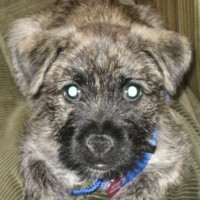Appearance of the Peka-A-West
|
| Peka-A-Wests grow to just 3.6 to 7 kilos and 20.5 to 25.5 centimeters in height, so they're a small, compact breed with a balanced blend of characteristics from their parent breeds. They look very much like smaller Westies, with darker coloring and certain Pekinese facial features, such as a relatively short muzzle and wide-set eyes. Note, however, that this hybrid also has small, high ears and separate hairs on the muzzle like a Westie. Apart from that, Peka-A-Wests have delicate but heavily padded paws and a medium-length, well-coated tail. The coat is medium to long and fairly dense. |
Temperament of the Peka-A-West
|
| The combination of Westie and Pekingese creates a well-balanced dog that is both alert and calm, active and relaxed, intelligent and affectionate. He develops strong bonds with family members and enjoys the company of people, both adults and children. Unlike some other Pekingese mixes, the Peka-A-West is exceptionally active due to its Terrier heritage. Nevertheless, it is not hyperactive, thanks to the calming effects of the discreet Pekinese personality. It can be a relatively easy dog to train due to its intelligence and tendency to seek affirmation from its owners. This trait also makes the breed affectionate and playful, so you'll be hard-pressed to see a Peka-A-West refusing a cuddle or romp session. On the other hand, Peka-A-Wests are hesitant, sometimes temperamental, with strangers. As such, socialization with people and other animals from an early age is important in raising a well-adjusted Peka-A-West. Overall, this breed retains many of the positive qualities of its parent breeds, and is ideally suited to families looking for an intelligent, affectionate pet. |
Needs and activities of the Peka-A-West
|
| The energy level of a Peka-A-West is somewhere between that of a low-key Pekingese and an energetic Westie. In general, these dogs need around 30 minutes of exercise a day. However, they may need more if they take after their Terrier parent. In any case, this hybrid is always eager for moderate walks, trips to the dog park, depending on temperament, and games like fetch. Because of their size and moderate activity requirements, Peka-A-Wests are ideal for owners living in urban environments or apartments in temperate climates. They will, however, thrive in any household and type of climate as long as they are treated like the mischievous lapdog they are. |
Maintenance of the Peka-A-West
|
| The Peka-A-West's moderate shedding and long coat require occasional maintenance in the form of brushing with a pin, comb or smooth brush. Ambitious owners can trim particularly long pieces of their dog's coat with scissors or clippers around the feet, ears and eyes. Otherwise, professional grooming is always an option. Peka-A-Wests should be bathed and have their nails trimmed at least once a month. Owners should also use a damp cloth to regularly clean their Peka-A-West's ears and eyes to prevent infections. In addition, Peka-A-Wests should brush their teeth daily to prevent dental disease. |









 English (United Kingdom)
English (United Kingdom)